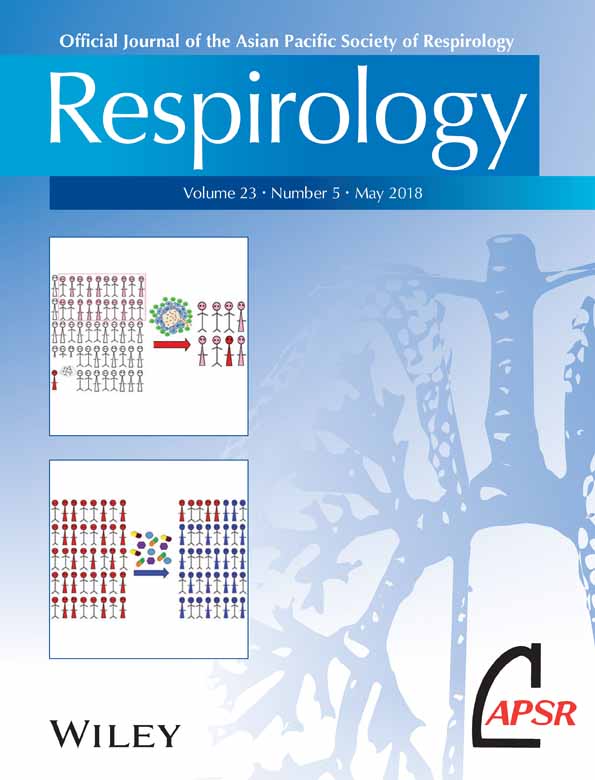Secondary spontaneous pneumothorax in idiopathic pulmonary fibrosis: Grim news
Abstract
The prognosis of idiopathic pulmonary fibrosis (IPF), the most common type of idiopathic interstitial pneumonia, remains poor. The median survival is 3–5 years from the time of diagnosis in symptomatic patients.1 There is, however, variability in the disease course, with some individuals having a slow progressive decline in their pulmonary function tests, while others demonstrate rapid or stepwise declines. Prognosis is not only affected by this variable progression rate, but also by the occurrence of acute exacerbations (which reduce median survival to approximately 3–4 months)2 as well as complications or co-morbidities. Common co-morbidities include emphysema, cardiovascular diseases, gastro-oesophageal reflux, obstructive sleep apnoea, lung cancer and pulmonary hypertension.1 In fact, approximately 20% of deaths in IPF patients are unrelated to the underlying disease biology.3
The article by Nishimoto et al. in this issue highlights the clinical relevance of another well known, but poorly reported complication of IPF, namely the appearance of a secondary spontaneous pneumothorax (SSP).4 Needless to say, pneumothorax in this population may also follow a transbronchial lung biopsy (incidence of 7.2% in a recent study),5 but data regarding the prognostic influence of iatrogenic pneumothorax on IPF outcome are lacking. The pathogenesis of SSP in the context of IPF is uncertain. It can hypothetically be attributed to the rupture of subpleural areas of honeycombing cysts. In contrast, the frequent coexistence of pulmonary fibrosis and emphysema does not seem to be a causative factor, since this4 and an earlier study6 were not able to demonstrate a significantly greater prevalence of emphysematous changes in IPF patients suffering from SSP. Nor does the potential miscategorization of pleuroparenchymal fibroelastosis as IPF seem to be a convincing explanation. In pleuroparenchymal fibroelastosis, a rare interstitial pneumonia in which SSP complicates the course in two-thirds of the patients,7 there is an upper lobe predilection with less marked or absent involvement of the lower lobes, though atypical cases exist.8
Overall, IPF is considered an uncommon cause of SSP. Nevertheless, in a recent series of 266 SSP, the second most frequent underlying pulmonary disease was interstitial pneumonitis or pulmonary fibrosis (7.9%), far behind chronic obstructive pulmonary disease (73.3%).9 The incidence of SSP in IPF is probably higher than classically reported (e.g. 6.4% in a series of 78 patients).10 For instance, in 56 consecutive patients with IPF who eventually died after being previously followed up for at least 6 months, 22 episodes of SSP developed in 17 (30%) patients.6 The initial SSP occurred at a mean of 9.1 months before death. Also, in the study by Nishimoto et al., 17 of 84 (20%) IPF patients developed SSP, with a cumulative increasing incidence over time.4 SSP was more likely in IPF patients with a lower body mass index and extensive reticular abnormalities on computed tomography. The median survival time from the onset of (first) SSP was 13.3 months, thus suggesting that this complication is ominous. In fact, during the observation period, the mortality rate was significantly higher in patients with SSP than in those without SSP (82.4% vs 41.8%).4 Contrary to the results of a previous study,6 a multivariate analysis supported SSP as an independent predictor of mortality (hazards ratio = 2.85), after adjusting for a number of confounding factors, such as age, gender and baseline forced vital capacity.4 The negative impact of SSP development on IPF survival is not unexpected, as this complication decreases the pulmonary function of patients with an already compromised pulmonary function. Worsening respiratory failure accounts for most of the deaths in subjects with IPF.
Notably, the study of Nishimoto et al. revealed that the recurrence rate of IPF-associated SSP was particularly high (70%), with 41% of intractable cases needing chest drainage during the remaining life span.4 An unexpandable lung resulting from parenchymal fibrotic stiffness explains the failure of the SSP to resolve. Not surprisingly, the most important risk factor for an unsuccessful surgical treatment (i.e. air leak site repair through video-assisted thoracoscopic surgery (VATS) or thoracotomy) in a series of 183 patients with different causes of SSP was interstitial pneumonia as the underlying disease (9 of 20 cases experienced treatment failure).11 Moreover, another study showed that the post-operative mortality rate was 21% in 14 patients with diffuse fibrotic pulmonary diseases who underwent surgical treatment for SSP.12 Undoubtedly, the management of SSP in IPF patients is challenging. After initial stabilization with chest tube drainage, an intervention is advocated to treat prolonged air leaks in some patients, and prevent recurrences in all. A common procedure is VATS with direct closure of the air leak, stapling/resection of any visible bleb and mechanical pleurodesis (e.g. abrasion with dry gauze). Unfortunately, many patients are not candidates for surgery and, therefore, bedside chemical pleurodesis using a blood patch or classical sclerosant agents become the alternative. Because SSP should prompt consideration for placing IPF patients on the lung transplantation list,13 one has to consider the effect of preventive measures on any subsequent lung transplantation. Even though pleurodesis is not a contraindication for future transplantation,13 it still represents a troublesome situation owing to the increased difficulty of the surgical procedure, the risk of excessive bleeding and the higher post-operative morbidity.
In summary, IPF patients who acutely deteriorate due to an SSP may have a dismal prognosis. The findings by Nishimoto et al. encourage future confirmatory prospective studies. In addition, failure of the fibrotic lung to re-expand makes IPF-associated SSP notoriously difficult to treat. Randomized controlled studies comparing different treatment modalities for SSP are urgently needed.




